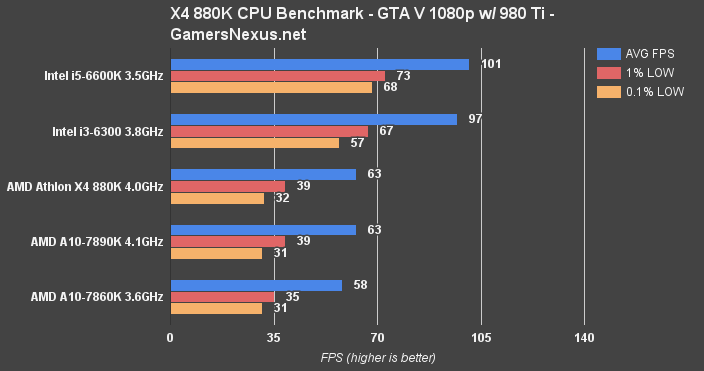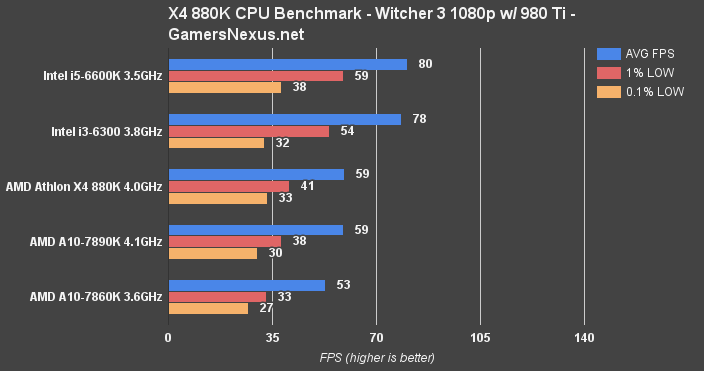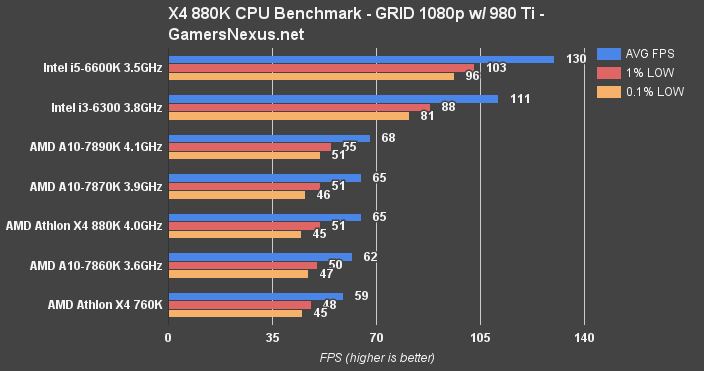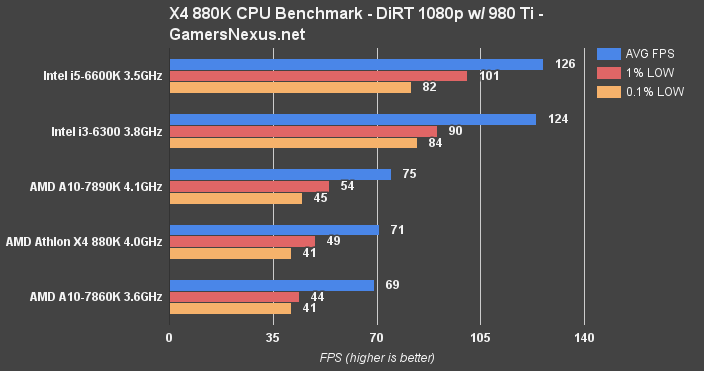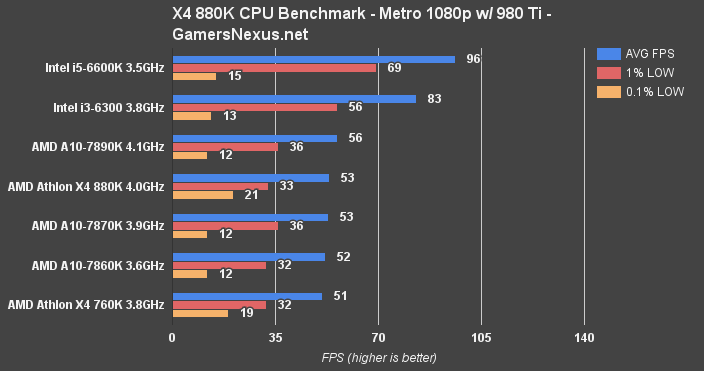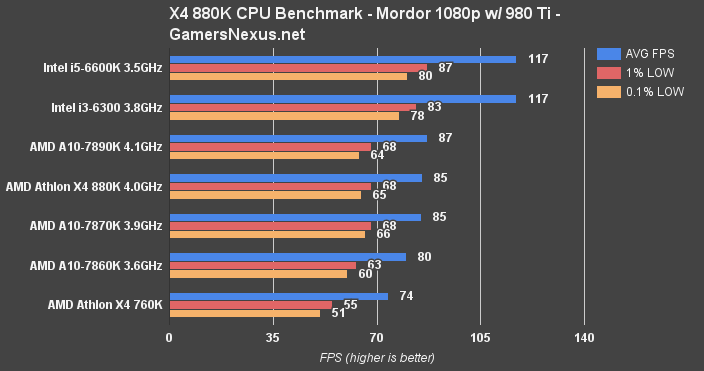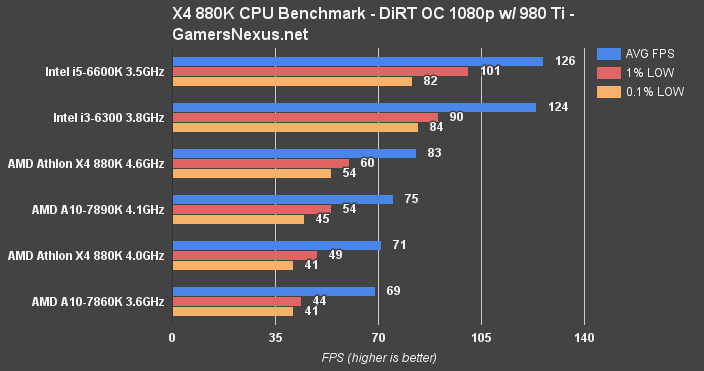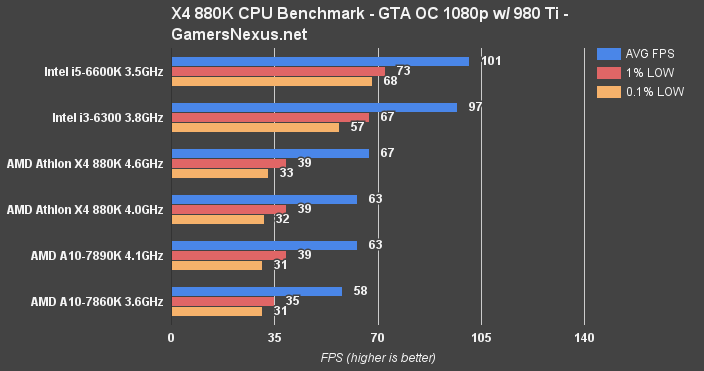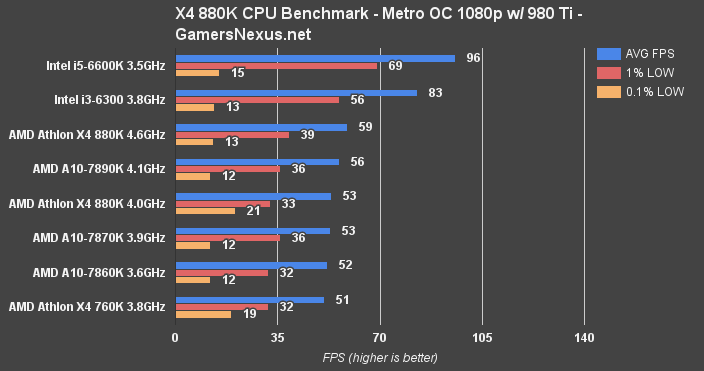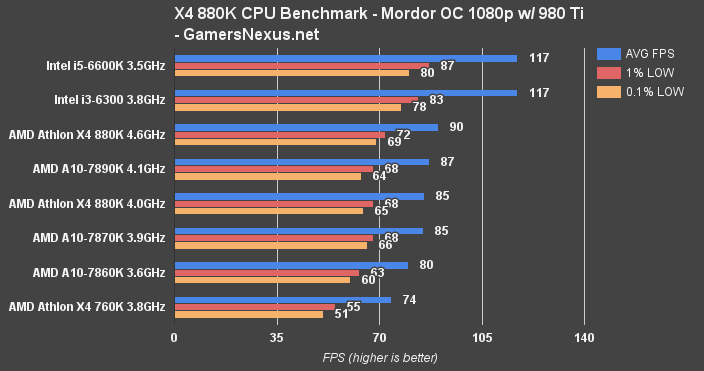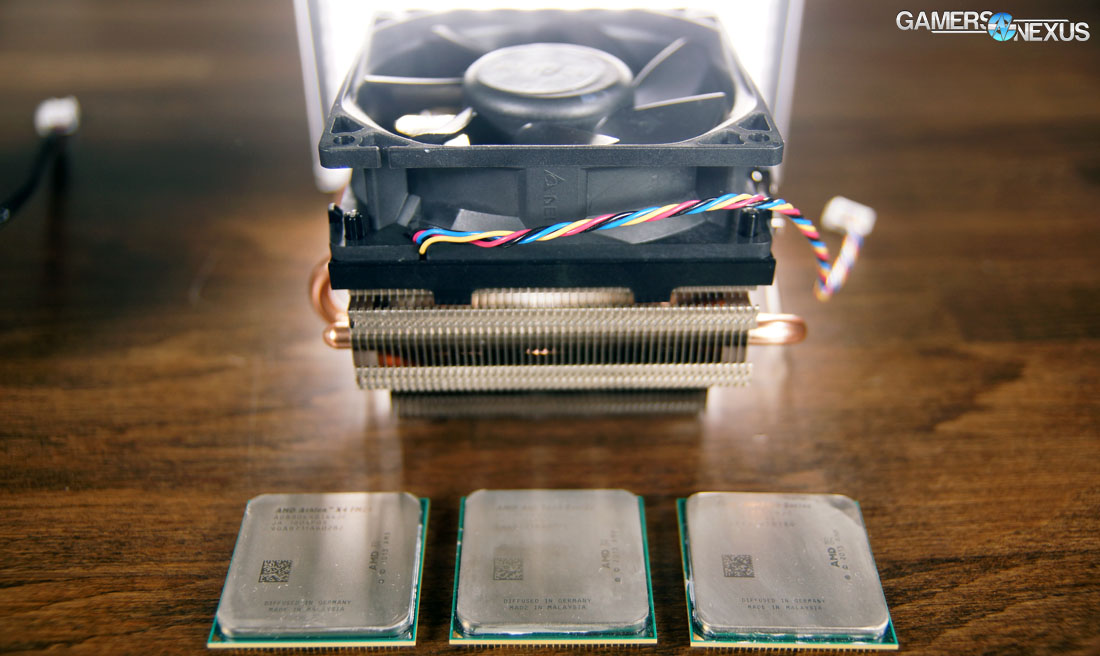The AMD Athlon X4 880K is the CPU we've been waiting for. Since the A10-7870K and A10-7860K APU reviews, our conclusions have generally been pointing in this direction. For the dGPU-using gaming audience, it makes better sense for budget buyers to grab a cheap CPU and dGPU than to buy an APU alone. There is a place for the APUs – ultra-budget, tiny, quiet HTPCs capable of video streaming and moderate gaming – but for more “core” gaming, the CPU + dGPU move currently does yield major gains. Even just throwing a 250X at an APU has, in some of our tests, nearly doubled gaming performance. For such a dirt-cheap video card, that's a big gain to be had.
And so AMD's Athlon X4 880K enters the scene. The price is all over the map right now. MSRP is $95 from AMD, but the X4 880K isn't (as of this writing) available through major first-party retailers like Amazon and Newegg. We've seen it for $104 from third-party Newegg sellers, but as low as $90 from sites we've never heard of, if you count those. In theory, though, the X4 880K will eventually come to rest at $95.
The new CPU is effectively a step between the 7870K and 7890K, but with the IGP disabled. This lowers validation cost while offering effectively equivalent CPU performance. AMD's X4 880K operates on a two-module, four-core Excavator architecture with a stock clock-rate of 4.0 to 4.2GHz (boosted). For comparison, the A10-7890K runs 4.1 to 4.3GHz, so there's a 100MHz gain over the X4 880K. Easily negated with overclocking, as the 880K is a K-SKU, multiplier-unlocked chip. The 880K has a 95W TDP and is paired with AMD's 125W near-silent (NS) cooler.
This review and benchmark of the Athlon X4 880K tests thermals, gaming (FPS) performance, and compares against higher-end i3 & i5 CPUs, APUs, and the old X4 760K.
AMD Athlon X4 880K vs. i3 CPU & 7870K APU – Video Review
AMD Athlon X4 880K Specs
| Athlon X4 880K | Athlon X4 860K | Athlon X4 870K | A10-7870K | |
| CPU Cores | 4 | 4 | 4 | |
| GPU Cores | N/A | N/A | N/A | 8 |
| Streaming Processors | N/A | N/A | N/A | 512 |
| Frequency / Turbo | 4.0 / 4.2GHz | 3.7 / 4.0GHz | 3.9 / 4.1GHz | 3.9 / 4.1GHz |
| GPU Frequency | N/A | N/A | N/A | 866MHz |
| TDP | 95W | 95W | 95W | 95W |
| Cooler | NS 125W | 95W NS | 95W NS | NS 125W |
| L2 Cache | 4MB | 4MB | 4MB | 4MB |
| Memory Support | DDR3-2133 | DDR3-1866 | DDR3-2133 | DDR3-2133 |
| PCI-e 3.0 Lanes | x16 | x16 | x16 | x16 |
| Clock Multiplier | Unlocked | Unlocked | Unlocked | Unlocked |
| Price | ~$95 to $105 | ~$70 to $80 | ~$90 | $140 |
Changes: AMD Athlon X4 880K vs. Athlon X4 860K
There's really no point to buy the Athlon X4 870K, at this point. The CPU shipped silently, saw almost no media coverage, and is now an odd-man-out for ~$90. It's a few bucks cheaper than MSRP of the 880K, which we imagine will soon completely phase-out the 870K.
The 860K is still a product worth looking at, though. It's $70 to $80 (more with the NS cooler) and on identical architecture to the 880K, but the 880K operates at a 300MHz higher base frequency. This is where some games will show a performance delta. We don't have an 860K for the bench (but hope to buy one out-of-pocket for testing), but do have an older X4 760K we ran through some games.
Other than this frequency difference, the only other major change is the cooler. The 860K ships with either the 95W cooler or the 125W cooler (the latter being the same as the 880K's), but for $10 more.
Test Methodology
We tested using our updated GPU test benches, detailed in the tables below. Our thanks to supporting hardware vendors for supplying some of the test components.
The latest AMD drivers (16.2 hotfix) were used for testing with the 250X. NVidia's 364.72 drivers were used for testing. Game settings were manually controlled for the DUT.
Testing was split between CPU bottleneck analysis and IGP benchmarks. To test at what point the CPU bottlenecks a high-end GPU, we equipped all platforms with a GTX 980 Ti and performed tests using the following settings:
Metro: Last Light - Very High w/ high tessellation.
GRID: Autosport - Ultra, 4xMSAA.
Shadow of Mordor - Ultra preset.
GTA V - Very High / High.
Witcher 3 – Ultra with no HairWorks and no AA.
DiRT Rally – Ultra, 4xMSAA.
All tests had the resolution set to 1080p.
Each game was tested for 30 seconds in an identical scenario, then repeated three times for parity.
Average FPS, 1% low, and 0.1% low times are measured. We do not measure maximum or minimum FPS results as we consider these numbers to be pure outliers. Instead, we take an average of the lowest 1% of results (1% low) to show real-world, noticeable dips; we then take an average of the lowest 0.1% of results for severe spikes. Anti-Aliasing was disabled in all tests except GRID: Autosport at Ultra (not medium), which looks significantly better with its default 4xMSAA.
Note that previous tests were reconducted to account for driver updates or changes to game software. We saw some improvements in a few cases, but generally the same results were output (the nature of using established games). Some changes in low values may be present due to modifications made in our methodology since the previous APU review, which was quite some time ago.
Learn about our chamber-validated thermal methodology in more depth here.
| GN Test Bench 2015 | Name | Courtesy Of | Cost |
| Video Card | GTX 980 Ti | NVIDIA AMD | - |
| CPU | Intel i5-6600K Intel i3-6300 | iBUYPOWER GamersNexus | - |
| Memory | 16GB HyperX Fury DDR4-2133 | Kingston Tech. | $62 |
| Motherboard | MSI Z170A SLI Plus | MSI | $140 |
| Power Supply | NZXT 1200W HALE90 V2 | NZXT | $300 |
| SSD | HyperX Predator PCI-e SSD | Kingston Tech. | TBD |
| Case | Top Deck Tech Station | GamersNexus | $250 |
| CPU Cooler | Be Quiet! Dark Rock 3 | Be Quiet! | ~$60 |
And the AMD bench:
| GN Test Bench 2015 | Name | Courtesy Of | Cost |
| Video Card | GTX 980 Ti | NVIDIA AMD | - |
| CPU | AMD A10-7890K AMD A10-7870K AMD Athlon X4 760K AMD Athlon X4 880K AMD A10-7860K | AMD GamersNexus | - |
| Memory | 16GB 2133MHz HyperX Savage RAM | Kingston Tech. | - |
| Motherboard | ASUS A88X-PRO | GamersNexus | $285 |
| Power Supply | NZXT 1200W HALE90 V2 | NZXT | $300 |
| SSD | HyperX Savage SSD | Kingston Tech. | TBD |
| Case | Top Deck Tech Station | GamersNexus | $250 |
| CPU Cooler | Be Quiet! Dark Rock 3 | Be Quiet! | ~$60 |
AMD Athlon X4 880K vs. 7870K, i3-6300, i5-6600K – GTA V
The X4 880K performs about identically to the 7890K in GTA V benchmarking – no surprise here. As will emerge to be a trend, the $50 more expensive i3-6300 holds a remarkable lead (~42.5%) over the X4 880K. Again, the $50 price gap is worth emphasis – but the 880K clearly bottlenecks the GPU at ~63FPS.
The 1% low and 0.1% low metrics yield nearly a consistent 60FPS low-end for the i3 CPU, which can't be said for the AMD devices. The X4 880K has some inconsistencies in framerate performance that loosen its average and low-end metrics, shown by the 32FPS and 39FPS averaged lows.
AMD Athlon X4 880K vs. 7870K, i3-6300, i5-6600K – Witcher 3
The Witcher 3 is abusive enough that the performance gaps shrink noticeably. The Athlon X4 880K sits shy of 60FPS with the 7890K (indistinguishable difference between them). There is a performance difference of roughly 28% between the i3-6300 and 880K. So far, then, an extra $50 yields somewhere between 28% and ~40% more performance, depending on title.
AMD Athlon X4 880K vs. 7870K, i3-6300, i5-6600K – GRID
GRID: Autosport is one of the most sensitive games we have when it comes to CPU frequency and thread-count changes. Without moving into the i7 range, the most powerful CPU on this bench pushes 130FPS average in the form of the 6600K ($245). The 6300 sees a reduction of 15.8%, but is still above 100FPS at 1080p. Then we hit a giant wall, and the AMD chips re-emerge in the 60FPS range. The X4 760K sits at 59FPS, and is championed by the 880K with a 9.6% delta. Massive bottleneck, but if you're looking to get a sub-$100 CPU and cheap dGPU – like a 750 Ti or R7 370, then the pairing makes sense for the price.
AMD Athlon X4 880K vs. 7870K, i3-6300, i5-6600K – DiRT
DiRT: Rally, like GRID, is a CPU-sensitive game. The Athlon X4 880K runs just under the 100MHz faster 7890K, and just above the 3.6GHz 7860K. A massive lead is held by the i3-6300 and, judging from the i5-6600K's performance, it looks like we start hitting other bottlenecks (GPU) in the 120+ FPS range.
AMD Athlon X4 880K vs. 7870K, i3-6300, i5-6600K – Metro: Last Light
Note that Metro: Last Light is uniquely picky about threads and will present poor 0.1% low metrics for just about every CPU except those with 8 available threads, like the i7 series CPUs.
At 1080p, the Athlon X4 880K predictably performs equally to the A10-7870K, being a simplified version of the $135 7870K APU. There's a clear CPU bottleneck established when we look to the i5-6600K as a control, which pushes nearly 96 FPS average. The i3-6300, priced at $150, eats into the performance with a 14.5% performance difference against the 6600K. The Athlon X4 880K suffers a 44% performance difference when matched against the i3-6300, though the Intel CPU is $50 higher, to be fair. It doesn't make any sense to opt for an IGP considering these first tests couple a dGPU with the CPUs, and the APUs see equal CPU performance. There is no noteworthy gain over the 760K in this benchmark, though that changes in a few other tests.
AMD Athlon X4 880K vs. 7870K, i3-6300, i5-6600K – Mordor
Shadow of Mordor is one of those. The old X4 760K performs at 74FPS average, a 13.8% difference from the new X4 880K. The APUs fall in between these Athlon chips, the 7870K again being effectively tied. No reason to buy that if buying a dGPU. The AMD devices are bottlenecking when compared to the i3-6300 ($150), a 31.7% difference between them, but still exceed 60FPS and are reasonable gaming chips for the price.
AMD Athlon X4 880K Overclocking Benchmarks
Overclocking efforts stopped at 4.6GHz, at which point we were unable to achieve a stable and reliable clock even with additional vCore or other UEFI tuning. The overclock isn't too impressive, but reasonable – and it was stable at 4.6GHz with no issues, always a positive. This isn't the kind of chip you buy for extreme overclocking endeavors; it's got a little extra power hidden under the hood, but it's no 5GHz hitter.
Performance deltas were generally ~5% to 10%, but some games (DiRT) saw larger gains.
See below:
AMD Athlon X4 880K Thermals
The AMD APU products are tough to get an accurate reading from. Most of the usual tools don't work, and the per-core readings are often inaccurate. Our current thermal bench for AMD CPUs is limited, but growing with each review. The X4 880K with its stock heatsink runs cooler than both the 7870K and 7860K when each is paired with their stock coolers. It's a surprisingly cool chip, aided by the fact that a large portion of the die – the IGP component of the APU – is disabled from use.
AMD's Athlon X4 880K uses what AMD calls its 125W Near-Silent cooler, the same as is found stock with the 7870K and 7860K. The Wraith is only found with the A10-7890K and some of the FX-8370 chips.
Read our full Wraith review here.
AMD Athlon X4 880K Conclusion
Until first-party retailers start listing the 880K, its pricing will remain sort of all over the place. The $95 MSRP makes the chip more viable than the $105 listings right now; even though it's only $10, that's $10 further from an 860K and $10 closer to an i3 – which performs markedly better. The nature of the 880K is to fill a small market gap, but one which is important – the sub-$100 CPU that's best paired with an affordable dGPU for budget gaming rigs.
The 880K makes infinitely more sense than an APU purchase for our core audience – if you're buying a dGPU, that IGP goes unused. The 880K cuts the price considerably by axing its IGP, but its CPU performance remains on-par with the 7870K and 7890K APU chips.
AMD has improved tremendously with its cooling solutions. This is one place where AMD has thoroughly beaten Intel, whose stock thermal solution leaves much to be desired. The stock 125W NS cooler for the 880K is sufficient for most users – even those playing with entry-level overclocking – and further keeps costs under control by negating the need to purchase a standalone cooler.
Thermal performance is good. Gaming performance is mostly acceptable – generally the CPU bottlenecks GPUs around 60FPS in more abusive games. It's tough to say what the staying power will be. Overclocking is generally unexcited, but is easily done for entry-level users seeking to play with clock and vCore changes.
UPDATE: After posting this review, a third-party seller on Newegg listed the X4 880K for $93. This makes the 880K an easy buy in the sub-$100 price range. It is well worth the extra $13 over the average 860K price, and far enough away from an i3 CPU that there are budget builds which would make better use of the 880K.
Editorial, Test Lead: Steve “Lelldorianx” Burke
Test Technician: Mike “Budekai” Gaglione
Video Production: Andrew “ColossalCake” Coleman
